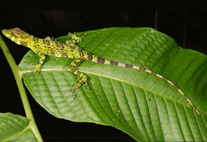Abstract
Recent work on molecular phylogenetics of Scolopendridae from the Western Ghats, Peninsular India, has suggested the presence of six cryptic species of the otostigmine Digitipes Attems, 1930, together with three species described in previous taxonomic work by Jangi and Dass (1984). Digitipes is the correct generic attribution for a monophyletic group of Indian species, these being united with three species from tropical Africa (including the type) that share a distomedial process on the ultimate leg femur of males that is otherwise unknown in Otostigminae. Second maxillary characters previously used in the diagnosis of Digitipes are dismissed because Indian species do not possess the putatively diagnostic character states. Two new species from the Western Ghats that correspond to groupings identified based on monophyly, sequence diver-gence and coalescent analysis using molecular data are diagnosed based on distinct morphological characters. They are D. jangii and D. periyarensis n. spp. Three species named by Jangi and Dass (Digitipes barnabasi, D. coonoorensis and D. indicus) are revised based on new collections; D. indicus is a junior subjective synonym of Arthrorhabdus jonesii Ver-hoeff, 1938, the combination becoming Digitipes jonesii (Verhoeff, 1938) n. comb. The presence of Arthrorhabdus in In-dia is accordingly refuted. Three putative species delimited by molecular and ecological data remain cryptic from the perspective of diagnostic morphological characters and are presently retained in D. barnabasi, D. jangii and D. jonesii. A molecularly-delimited species that resolved as sister group to a well-supported clade of Indian Digitipes is identified as Otostigmus ruficeps Pocock, 1890, originally described from a single specimen and revised herein. One Indian species originally assigned to Digitipes, D. gravelyi, deviates from confidently-assigned Digitipes with respect to several charac-ters and is reassigned to Otostigmus, as O. gravelyi (Jangi and Dass, 1984) n. comb.
References
Attems, C. (1930a) Scolopendromorpha du Congo Belge. Revue de Zoologie et de Botanique Africaines, 19, 287–294.
Attems, C. (1930b) Myriapoda 2. Scolopendromorpha. In: Schulze, F. E. & Kükenthal,W. (eds.), Das Tierreich, 54. Walter de Gruyter, Berlin, pp. 1–308.
Bonato, L., Edgecombe, G.D., Lewis, J.G.E., Minelli, A., Pereira, L.A., Shelley, R.M. & Zapparoli, M. (2010) A common terminology for the external anatomy of centipedes (Chilopoda). ZooKeys, 69, 17–51.
http://dx.doi.org/10.3897/zookeys.69.737Brölemann, H.W. (1902) Myriapodes des Musée de São Paulo. Revista do Museu Paulista, 5, 35–237.
Chagas-Jr., A., Knysak, I. & Guizze, S.P.G. (2007) Revalidation of the subgenus Dactylotergitius Verhoeff, and redescription of Otostigmus (D.) caudatus Brölemann and Otostigmus (D.) cavalcantii Bücherl (Scolopendromorpha : Scolopendridae : Otostigminae). Zootaxa, 1639, 57–67.
Dobroruka, L.J. (1968) Myriapoda-Chilopoda aus der Sammlung des Musée Royal de l’Afrique Centrale. Revue de Zoologie et de Botanique Africaines, 78, 201–215.
Jangi, B.S. & Dass, C.M. (1984) Scolopendridae of the Deccan. Journal of Scientific and Industrial Research, 43, 27–54.
Joshi, J. & Karanth, K.P. (2011) Cretaceous-Tertiary diversification among select scolopendrid centipedes of South India. Molecular Phylogenetics and Evolution, 60, 287–294.
http://dx.doi.org/10.1016/j.ympev.2011.04.024Joshi, J. & Karanth, K.P. (2012) Coalescent method in conjunction with niche modelling reveals cryptic diversity among centipedes in the Western Ghats of South India. PLoS ONE, 7, e42225.
http://dx.doi.org/10.1371/journal.pone.0042225Kraepelin, K. (1903) Revision der Scolopendriden. Jahrbuch der Hamburgischen wissenschaftlichen Anstalten, (2)20, 1–276.
Kraus, O. (1957) Eine kleine Myriapoden-Ausbeute aus Katanga (Belgisch Congo). Revue de Zoologie et de Botanique Africaines, 55, 396–404.
Lewis, J.G.E. (1996) The type specimens and identity of the species described in the genus Otostigmus (subgenus Otostigmus) by R.I. Pocock in the collections of the Natural History Museum, London (Scolopendromorpha: Scolopendridae). Journal of Natural History, 30, 823–834.
http://dx.doi.org/10.1080/00222939600770451Lewis, J.G.E. (2001) The scolopendrid centipedes in the collection of the National Museum of Natural History in Sofia (Chilopoda: Scolopendromorpha: Scolopendridae). Historia naturalis bulgarica, 13, 5–51.
Lewis, J.G.E. (2004) Redescription and reassignment of the type material of the African centipedes Otostigmus reichardti Kraepelin and Otostigmus tanganjikus Verhoeff, with remarks on the genera Digitipes Attems, Otostigmus Porat and Rhysida Wood (Chilopoda: Scolopendromorpha). African Invertebrates, 45, 279–286.
Lewis, J.G.E. (2010a) A revision of the rugulosus group of Otostigmus subgenus Otostigmus Porat, 1876 (Chilopoda: Scolopendromorpha: Scolopendridae). Zootaxa, 2579, 1–29.
Lewis, J.G.E. (2010b) A key and annotated list of the Scolopendra species of the Old World with a reappraisal of Arthrorhabus (Chilopoda: Scolopendromorpha: Scolopendridae). International Journal of Myriapodology, 3, 83–122.
http://dx.doi.org/10.1163/187525410X12578602960380Pocock, R.I. (1890) Report upon a small collection of scorpions and centipedes sent from Madras by Mr. Edgar Thurston, of the Government Central Museum. Annals and Magazine of Natural History, Series 6, 5, 236–250.
http://dx.doi.org/10.1080/00222939009460821Pocock, R.I. (1891) Notes on the synonymy of some species of Scolopendridae, with descriptions of new genera and species of the group. Annals and Magazine of Natural History, Series 6, 7, 51–68, 221–231.
http://dx.doi.org/10.1080/00222939109460598Porat, C.O. v. (1876) Om några exotiska myriopoder. Bihang till Kongliga Svenska Vetenskaps-Akademien Handlingar, 4, 7, 1–48.
Schileyko, A.A. (1995) The scolopendromorph centipedes of Vietnam (Chilopoda Scolopendromorpha). Part 2. Arthropoda Selecta, 4, 73–87.
Sureshan, P.M., Yadav, B.E. & Radhakrishnan, C. (2003) An illustrated key to the identification of centipedes (Chilopoda: Scolopendromorpha) of Kerala. Zoos’ Print Journal, 19, 1401–1407.
Sureshan, P.M., Khanna, V. & Radhakrishnan, C. (2006) Additional distributional records of scolopendrid centipedes (Chilopoda: Scolopendromorpha) from Kerala. Zoos’ Print Journal, 21, 2285–2291.
Vahtera, V., Edgecombe, G.D. & Giribet, G. (2012) Evolution of blindness in scolopendromorph centipedes (Chilopoda: Scolopendromorpha): insight from an expanded sampling of molecular data. Cladistics, 28, 4–20.
http://dx.doi.org/10.1111/j.1096-0031.2011.00361.xVerhoeff, K.W. (1938) Chilopoden-Studien, zur Kenntnis der Epimorphen. Zoologische Jahrbücher, Abteilung für Systematik, Ökologie und Geographie der Tiere, 71, 339–388.
Yadav, B. E. (1993a) On a collection of centipedes (Myriapoda : Chilopoda) from Pune, Maharashtra. Records of the Zoological Survey of India, 93, 165–174.
Yadav, B.E. (1993b) Scolopendridae (Chilopoda) of Western Ghat with some first records from the State of Maharastra, India. Records of the Zoological Survey of India, 93, 321–328.

